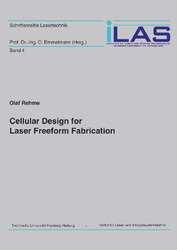| Areas | |
|---|---|
| Serie de libros (96) |
1378
|
| Nachhaltigkeit |
3
|
| Gesundheitswesen |
1
|
| Letra |
2364
|
| Ciencias Naturales |
5406
|
| Ciencias Ingeniería |
1793
|
| Ingeniería | 292 |
| Ingeniería mecánica y de proceso | 862 |
| Ingeniería eléctrica | 686 |
| Mineria y metalurgía | 30 |
| Arquitectura e ingeniería civil | 75 |
| General |
98
|
|
Leitlinien Unfallchirurgie
5. Auflage bestellen |
|
Erweiterte Suche
Cellular Design for Laser Freeform Fabrication (Volumen 4) (Tienda española)
Olaf Rehme (Autor)Previo
Indice, Datei (39 KB)
Lectura de prueba, Datei (210 KB)
Cellular materials are spread all across the world. They can be found in nature, e.g. in bone
and wood, as well as in engineering applications such as honeycomb sheets and aluminum
foams to name but a few. Cellular materials have some unique properties which allow new
and innovative applications beyond the scope of solid engineering materials. Especially their
low density and therefore their outstanding stiffness-to-weight-ratio is of greatest importance
in most applications. Functions of cellular materials could be lightweight structures of high
stiffness, damping and absorption of mechanical energy, vibration control, acoustic
absorption, heat exchange, filtering and numerous other tasks. Generally, a combination of
these tasks in one part exhibits an optimized and therefore innovative overall performance.
One recent development in production technologies is the field of Laser Freeform Fabrication
(LFF) processes where parts are manufactured by application of thin layers of powder or
sometimes liquid material. A laser beam melts and solidifies the material along contour lines
and hatch areas according to slices of a corresponding 3D-CAD model. Among these
processes the Selective Laser Melting (SLM) technology was advanced based upon the work
in this thesis to allow the manufacture of periodic, open-cell lattice structures from
engineering materials such as stainless steel, titanium, etc. In contrast to other cellular
materials these lattice structures can be of well-defined, nearly arbitrary shape. Due to the
layerwise fabrication the SLM process is also capable of creating lattice cores surrounded by
solid shells allowing new degrees of geometric freedom in engineering design that was never
experienced before in conventional machining. This allows the development of interesting
new applications such as medical implants where the main issues are the improvement of
osseointegration and realization of physioelastic material properties for an optimized bond
between the implant and surrounding tissue. Lattice structures obtained from the SLM process
can meet these requirements.
This thesis contributes to the understanding of the mechanical properties of the new material
class of SLM lattice structures. Their future incorporation in engineering designs requires a
profound knowledge of failure mechanisms and operational limits. Therefore, a
comprehensive summary is given on the state-of-the-art of cellular materials followed by a
dedicated analysis on Laser Freeform Fabrication and an in-depth validation of the Selective
Laser Melting capabilities. Readers with advanced knowledge on cellular materials or Laser
Freeform Fabrication may skip sections 2 or 3, respectively. Next, all process constraints and
boundary conditions for the manufacture of SLM lattice structures are elaborated. Then a
bilateral approach was chosen to derive scaling laws and optimize the SLM lattice structures
for given tasks. Firstly, a theoretical analysis comprises the examination of structural
hypotheses for isotropic cellular materials before a generalized theory is developed for
anisotropic SLM lattice structures. Different cubic, polyhedral and rhombic cell types are
evaluated towards their producibility. Some of these cell types are preselected and are subject
to numerical analysis where their mechanical properties are derived on the basis of the space
framework theory. Secondly, an extensive experimental evaluation of test specimens is given.
This includes examinations of the properties of SLM solids, the producibility of SLM lattice
structures in terms of dimensions and testing of their mechanical properties such as strength
and elasticity in compression, tension and shear load. The test procedures are divided in three
stages. The first stage comprises the examination of the specific strength in dependence of the
cell type to narrow down few optimum cell types for different applications. In the second and
third stage these cell types are investigated towards their elasticity and strength in dependence
of the cell size. Finally, this thesis concludes with scaling laws provided in accordance with
the theoretical and experimental results. Opposed to simple power laws used for cellular
materials these newly developed scaling laws consider leaps in properties at higher, so-called
critical relative densities which can be obtained from SLM due to its high degree of design
freedom. At the critical relative density SLM lattice structures cease being frameworks and
become rather solids with pores.
For future applications these scaling laws can be applied by design engineers to match
particular requirements that can only be fulfilled by Laser Freeform Fabrication and its
degrees of freedom in design. For the sake of completeness some sample applications in the
field of medical implants are given in this thesis, which involve these scaling laws.
| ISBN-10 (Impresion) | 3869552735 |
| ISBN-13 (Impresion) | 9783869552736 |
| ISBN-13 (E-Book) | 9783736932739 |
| Formato | A5 |
| Idioma | Inglés |
| Numero de paginas | 304 |
| Laminacion de la cubierta | Brillante |
| Edicion | 1 Aufl. |
| Serie | Schriftenreihe Lasertechnik |
| Volumen | 4 |
| Lugar de publicacion | Göttingen |
| Lugar de la disertacion | TU Hamburg |
| Fecha de publicacion | 18.03.2010 |
| Clasificacion simple | Tesis doctoral |
| Area |
Ingeniería mecánica y de proceso
|








